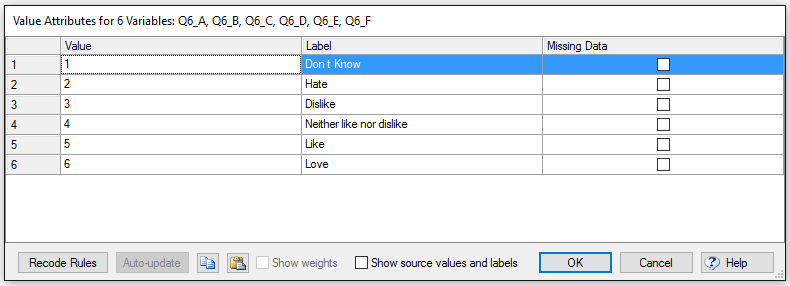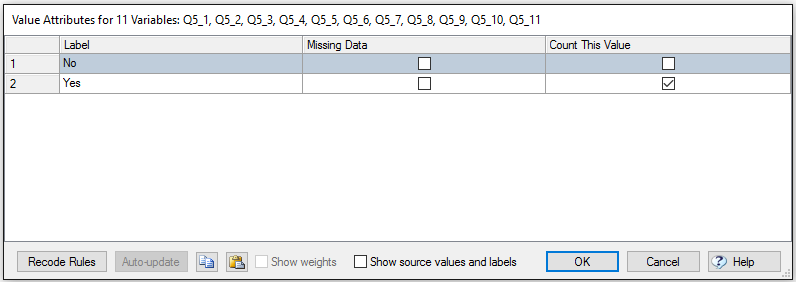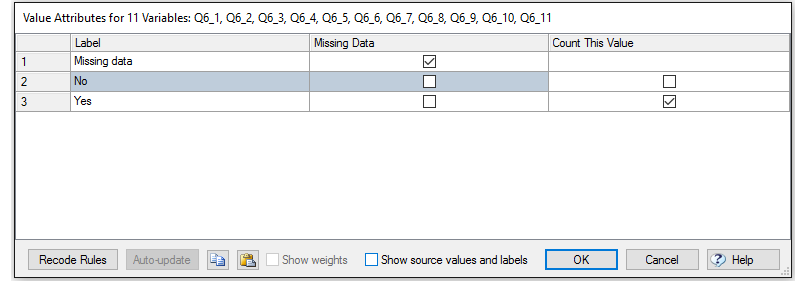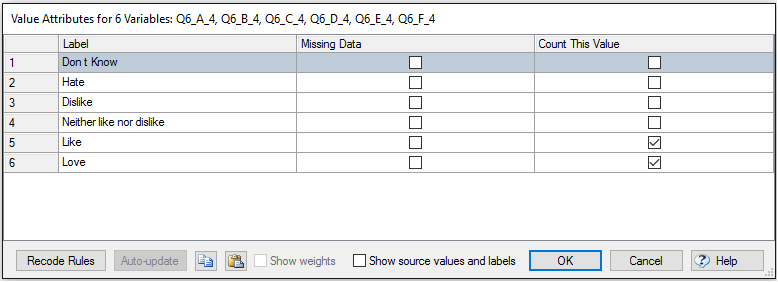Value Attributes
| Related Online Training modules | |
|---|---|
| Editing Values | |
| Recoding Ranges of Values | |
| Changing Part of a Question | |
| Generally it is best to access online training from within Q by selecting Help > Online Training |
| Related Videos | |
|---|---|
|
Part 2 of Creating and Modifying Variables (Video) |
The Value Attributes are key metadata relating to individual variables and this metadata is inspected and modified in the Value Attributes dialox box (among other places).
Editing Value Attributes
The Value Attributes dialog box can be opened by:
- Right-clicking on the row or column category names in the Outputs Tab and selecting Values.
- Pressing the
 on the Variables and Questions tab.
on the Variables and Questions tab. - Pressing Status for a variable in the Variables and Questions tab where it is a color other than green.
- Using Set Question to create a Pick Any or Pick Any - Grid question.
When the Values button is pressed to get the Value Attributes dialog box, any changes will be made to whichever variables are selected (in much the same way as do repeat commands and loops in some programs).
If you select only a subset of variables that make up a question, Q will ask This variable is part of a larger Question. Would you like to edit all of the Question’s Variables at once? If you select Yes, all the variables in the question will be selected and any changes made will apply to all the questions. If you select No, changes will only apply to the selected variable(s) (you should only select No with considerable care, as any resulting changes can be easily misinterpreted).
Sometimes a warning will appear saying Warning: the data file contains information suggesting the variables you have selected are fundamentally different. Are you sure you want to proceed? If you select Yes, changes made will apply to all the selected variables, regardless of the actual meaning of the variables. For example, if one of the selected variables was gender and the other age, if you changed the label corresponding to Men to, say, Male, this label would also be applied to the same value of the age variable.
If the cells contain grey fonts or the check-boxes are neither checked nor unchecked it indicates that:
- The selected variables have different value attributes, or,
- If it is a Value it may also mean that Recode Rules have been specified.
Buttons, Options and Fields
Value The numeric value assigned to the calculation and used when computing Statistics applicable to numeric data, such as the Average and Standard Deviation.
Label Any labels can be altered in this dialog box. Changes made here will override any changes made to categories by selecting Rename on the Outputs Tab.
Missing Data Observations containing a response which has been checked as Missing Data are automatically excluded from any analyses (i.e., calculations in tables are re-based).
Count This Value Categories to be used in computing percentages when the question is tabulated (i.e., as a part of Pick Any and Pick Any - Grid questions.
Show source values and labels Causes the original (i.e., ‘source’) values and labels (i.e., Source Values and Source Labels) to appear.
Show weights Causes two additional columns to appear: Current Sample Size and Population Target. The Current Sample Size shows the number of observations currently in each category. By default, the Population Target contains the same values as the Current Sample Size. However, when the values of Population Target... are changed, the corresponding Value also changes (to the value of Population Target ÷ Current Sample Size). This procedure is appropriate when using the resulting variable for weighting. See Weighting for other, more powerful, ways of creating weights.
- Auto-update Causes the values of Population Target and Value to be updated such that if the variable is used for weighting, the weighted sample size will be equivalent to the un-weighted sample size.
![]() Copy Copies all Value Attributes to the clipboard, to allow them to be pasted to Excel or to another variable's Value Attributes in Q. You may also select multiple rows at once and press CTRL+C to only copy the data from those rows.
Copy Copies all Value Attributes to the clipboard, to allow them to be pasted to Excel or to another variable's Value Attributes in Q. You may also select multiple rows at once and press CTRL+C to only copy the data from those rows.
![]() Paste Replaces this variable's Value Attributes with those of the clipboard, starting at the currently selected row. You will be prompted to choose which columns to replace.
Paste Replaces this variable's Value Attributes with those of the clipboard, starting at the currently selected row. You will be prompted to choose which columns to replace.
Aggregation, Period type and All data are described at Setting Time Periods for Date Questions.
Examples
For most Question Types the Value Attributes window will show three columns, Value, Label, and Missing Data, with one row representing each unique value in the data:
You can modify contents of each column to change the way the data is treated:
- The numbers in the Value column can be changed to recode the data. This will change how the Average, Standard Deviation, and other numeric statistics are computed in the Statistics - Below and Statistics - Right (for For Pick One and Pick One - Multi questions) or the Statistics - Cells (for Number and Number - Multi questions).
- The contents of the Label column will change the category labels in the table.
- Any rows ticked in the Missing Data column will be excluded from the sample whenever this question is shown in a table or used in other analyses.
Pick Any Questions
Multiple response data, which usually appears as Pick Any or Pick Any - Grid in Q, has a different Value Attributes window. There is a column called Count This Value which is used to tell Q which response codes should be counted in the table for this question, and there is no Value column, as the numeric values do not play a role for this kind of data.
No Missing Data
This question has two possible response codes for each option: Yes and No. The selections in the Count This Value column indicate that in the table, when calculating the percentages and other statistics, we only want to count people who said Yes for each response. As neither of the rows are ticked in the Missing Data column, the base sample for each row will be the total sample.
Regardless of the labels and values, if your Pick Any question only has two possible response codes, one must be ticked in the Count This Value column, and the other must be un-ticked. Neither of the values should be ticked in the Missing Data column as this will result in tables where every category is either 0% or 100%.
Missing Data
This question has a third possible response code for each survey option: Missing data. This typically means that some respondents skipped over the question when completing the survey, or that some respondents did not see all of the options (for example, if some brands were not relevant to the respondent due to their answers to previous questions).
The selections in the Count This Value column are the same as the previous case, indication that we will count all respondents who answered Yes for each option. The Missing data category is ticked in the Missing Data column, and this means that the base sample for each category will be all those respondents who do not have missing data. In this case, if you want to base the statistics on the total sample, you can un-tick the box in the Missing Data column, and the Missing data category will then be treated just the same as the No category.
Top Boxes
When you have categorical data, for example a 5-point scale, and you want to know how many respondents selected the top 2 responses (or top 3, bottom 2, etc) then changing the Question Type to Pick Any allows you to set this up using the Value Attributes. In this example, the table will count all respondents who gave an answer of Love or Like for this scale.
For more on top boxes, see How to Compute Top 2 Box Scores.



